-
Fall 2022
-
Professor Bousman elected to Fellowship of the Society of Antiquaries of Scotland
At its annual meeting the Society of Antiquaries of Scotland nominated and elected Professor Bousman as Fellow. The Society was established in 1780 and is considered the premier learned archaeological society in Scotland and one of the most influential in the UK. Professor Bousman was deeply honored for his election.
-
Dr. Angela VandenBroek on Platypod, The CASTAC Podcast
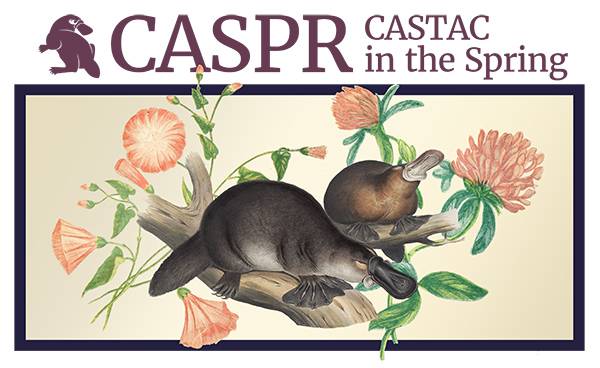 Dr. Angela VandenBroek was recently interviewed on the Platypod Podcast. This episode presents a recording of CASPR 2022, or the CASTAC in the Spring 2022 mentoring event, which took place on May 10, 2022. CASPR 2022 was organized to encourage dialogue on breaking down binaries that have separated academe and industry. Angela VandenBroek (TXTS), Melissa Cefkin (Waymo), and Dawn Nafus (Intel) discuss their work in leading socially-informed research in industry contexts.
Dr. Angela VandenBroek was recently interviewed on the Platypod Podcast. This episode presents a recording of CASPR 2022, or the CASTAC in the Spring 2022 mentoring event, which took place on May 10, 2022. CASPR 2022 was organized to encourage dialogue on breaking down binaries that have separated academe and industry. Angela VandenBroek (TXTS), Melissa Cefkin (Waymo), and Dawn Nafus (Intel) discuss their work in leading socially-informed research in industry contexts.This episode was created with the participation of Angela VandenBroek (Texas State University, speaker, CASTAC web producer), Melissa Cefkin (Waymo), Dawn Nafus (Intel), Patricia G. Lange (California College of the Arts, host), and Svetlana Borodina (Columbia University, producer, sound editor). The episode is available on the Platypod website, Spotify, Apple Podcasts, and Stitcher.
-
TXST at the AAA annual meeting
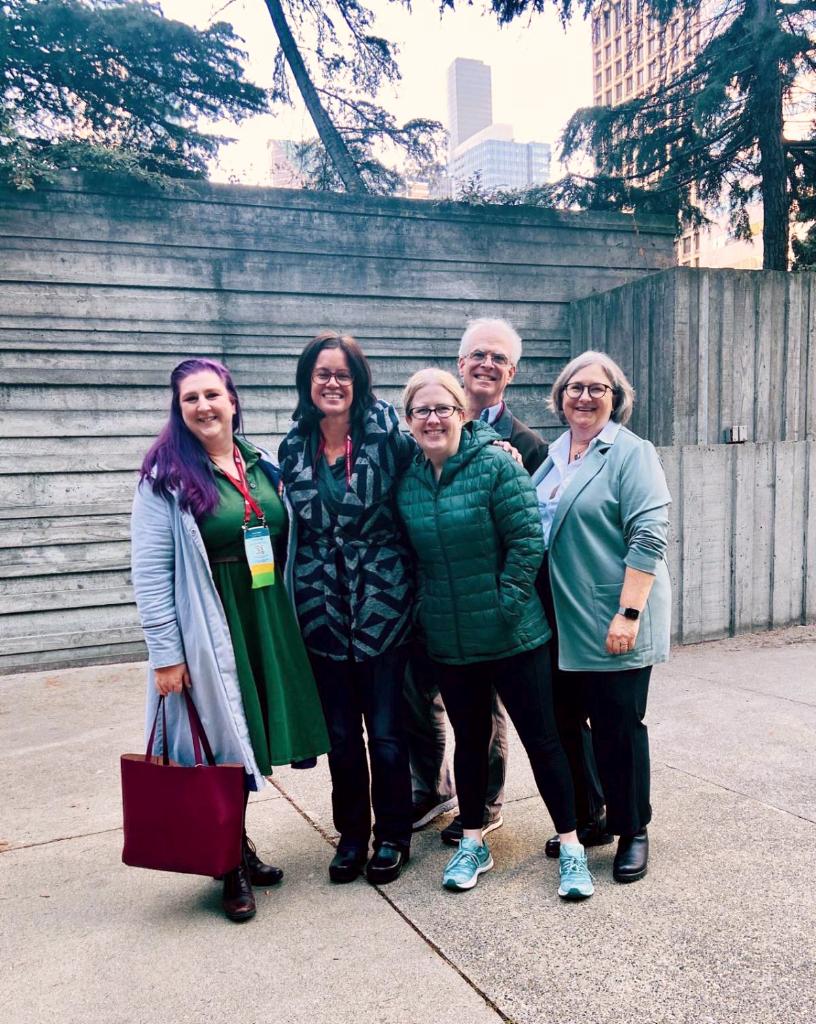 TXST faculty attended and presented at the American Anthropological Association meeting in Seattle last week!
TXST faculty attended and presented at the American Anthropological Association meeting in Seattle last week!Pictured: Drs. VandenBroek, Taylor, Brunson, Warms and Schoch-Spana
-
Drs. Brunson and Schoch-Spana win award!
 Drs. Brunson and Schoch-Spana (on behalf of the CommuniVax coalition which they co-lead) were awarded the 2022 ARHE Policy Brief Award at the AAA meeting. Congratulations Emily and Monica!
Drs. Brunson and Schoch-Spana (on behalf of the CommuniVax coalition which they co-lead) were awarded the 2022 ARHE Policy Brief Award at the AAA meeting. Congratulations Emily and Monica! -
Two New Funding Awards for the Center for Archaeological Studies
The Center for Archaeological Studies recently received two sources of funding:
Amy Reid and Kelsie Hart's proposal was selected as a recipient of the FY2023 Texas Preservation Trust Fund Grant. The award of $17,169 will be used to rehabilitate and curate the 1983-1987 Zatopec Site Collection.
CAS also signed a new contract with New South Associates, Inc. for our upcoming FY23 Veterans Curation Program session. This contract provides $254,044 in funding to hire four new student Veterans, and also fund two assistant lab managers. The VCP provides employment and vocational training for recently separated veterans using archaeological collections administered by the U.S. Army Corps of Engineers. Veterans working in the CAS laboratory are being trained in data entry, report writing, photography, and scanning technologies. The veterans are helping the Corps rehabilitate archaeological collections and associated records for long-term curation and future research.
-
Faculty Brown Bag | Dr. Britt Bousman: Neolithic Archaeology and Sacred Landscapes on the Orkney Islands
Join the Department of Anthropology for their Faculty Brown Bag Lecture Series, featuring Dr. Britt Bousman.
Friday, November 18, 2022 | 12:00 pm
Dr. Bousman will be speaking on "Neolithic Archaeology and Sacred Landscapes on the Orkney Islands." Contact Dr. Nick Carter for more information and to get the Zoom link.
-
Dr. David Kilby publishes research on Clovis mammoth hunting debate
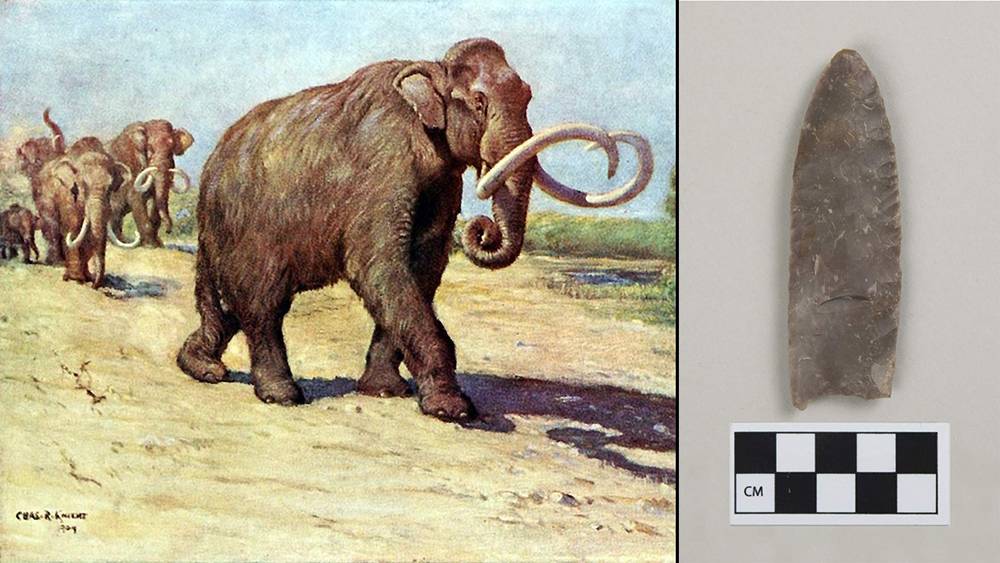 The Clovis culture, known for its distinctive style of stone projectile points, roamed North America between 13,500 and 12,500 years ago. They have long been viewed as effective hunters who preyed on mammoths, mastodons, bison and other megafauna of the Ice Age, but a team of researchers led by archaeologist Metin Eren of Kent State University challenged this understanding in a 2021 paper published in Journal of Archaeological Science: Reports.
The Clovis culture, known for its distinctive style of stone projectile points, roamed North America between 13,500 and 12,500 years ago. They have long been viewed as effective hunters who preyed on mammoths, mastodons, bison and other megafauna of the Ice Age, but a team of researchers led by archaeologist Metin Eren of Kent State University challenged this understanding in a 2021 paper published in Journal of Archaeological Science: Reports.In the paper, Eren’s team argued that Clovis spear points lack the penetrating capability necessary to kill prehistoric mammoths and other proboscideans and were more likely used for butchering scavenged carcasses.
Now, new analysis conducted by a research team led by David Kilby, a professor in the Department of Anthropology at Texas State University, finds that Eren et al’s findings are likely in error, and confirms that Clovis points were designed and used to hunt large Ice Age mammals. The research team, including Todd Surovell (University of Wyoming), Bruce B. Huckell (University of New Mexico), Chris Ringstaff (Texas Department of Transportation), Marcus J. Hamilton (University of Texas at San Antonio) and C. Vance Haynes (University of Arizona), publish their report, "Evidence Supports the Efficacy of Clovis Points for Hunting Proboscideans," in the Journal of Archaeological Science: Reports, Volume 45.
“Our paper closely examines their argument and tests it against experimental, ethnographic, and archaeological evidence, and our results confirm that Clovis points were indeed effective weapons used to hunt mammoth, mastodon and gomphotheres in Ice Age North America,” Kilby said.
One flaw Kilby’s team identified in the 2021 study is that Eren’s conclusions rely heavily on comparing experimental results to the anatomy of woolly mammoth, which is characterized by thick layers of fat and a dense coat of woolly hair. In addition to protecting them from the cold, Eren’s team argued that the combination of fat and wool offered woolly mammoth significant protection from the Clovis spear points used by Ice Age hunters.
However, Kilby noted that no Clovis points have ever been found in association with woolly mammoths. Instead, Clovis points are associated with the Columbian mammoth, as well as single cases of mastodon and gomphothere — none of which are known to have shared the cold weather adaptations of their woolly cousins. Kilby’s team calculated that without those extra layers, the vital organs were within range of the penetrative depths of Clovis points reported by Eren’s team.
Furthermore, Kilby’s team questioned Eren’s use of a compound bow and wet clay to simulate Clovis mammoth hunting. Specifically, homogenous wet clay is a poor representation of complex animal tissue, and a compound bow does not replicate the physics of a manually thrusted spear or any other technique believed to have been used by the hunters of the era.
Kilby’s study reviewed ethnographic and experimental studies from the 20th century documenting that African hunters armed with only spears are capable of successfully hunting elephants, and that archaeological experiments using recently deceased elephant carcasses demonstrated that stone Clovis spear points can penetrate deeply enough to reach vital organs.
Believing that the ultimate test of an archaeological idea is how well it is supported by the archaeological record, the authors next analyzed the distribution of Clovis points across different kinds of sites. They found that the distribution of complete and broken points from kill sites and camp sites met expectations for their use as hunting weaponry and that all examined Clovis sites traditionally interpreted as kills included points that exhibit damage related to impact.
Kilby’s team concluded from all available evidence that Clovis spear points were used as weapons to hunt large Ice Age mammals including proboscideans and while they were clearly also used for cutting and other tasks, Clovis points were primarily designed to perform efficiently as weapons tips for hunting.
-
Anthropology Graduate Student Workshop
 Join the Anthropology Department for a workshop aimed at helping current Texas State Undergraduate Anthropology majors and minors navigate the path into graduate school.
Join the Anthropology Department for a workshop aimed at helping current Texas State Undergraduate Anthropology majors and minors navigate the path into graduate school. Date | Thursday, November 17, 2022, Online via Zoom
Time | 4:00 – 5:20 p.m.Visit the Graduate Student Workshop Event Page for full details and registration Information.
-
Meet The Professors
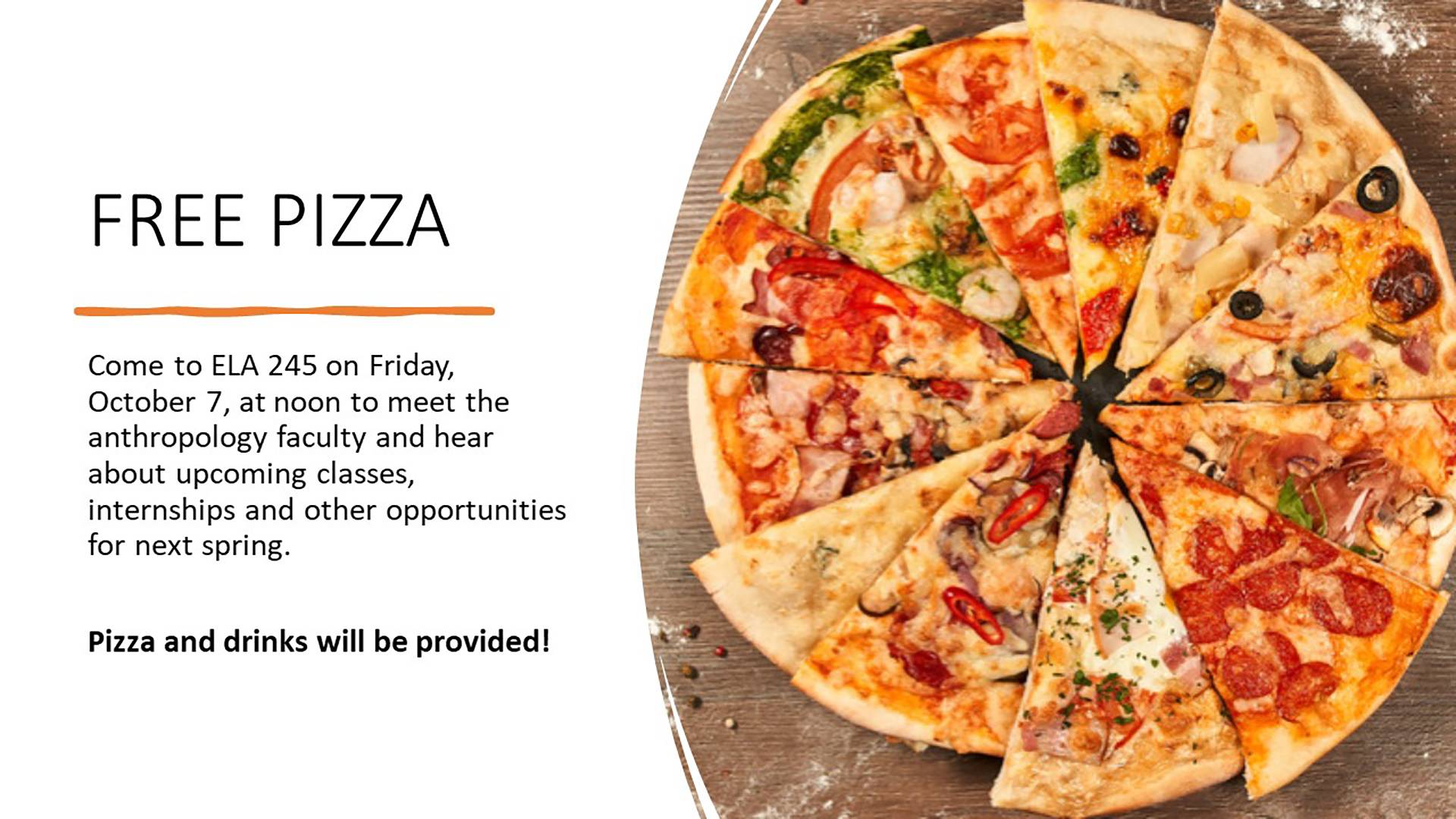 Come to ELA 245 on Friday, October 7, to meet the anthropology faculty and hear about upcoming classes, internships and other opportunities for next spring.
Come to ELA 245 on Friday, October 7, to meet the anthropology faculty and hear about upcoming classes, internships and other opportunities for next spring.Date/Time | Friday, October 7, 2022 @ 12:00 pm
Location | ELA 245Pizza and drinks will be provided!
-
Project Huaca del Loro featured on the Peruvian national news
Project Huaca de Loro, led by Anthropology professor Christina Conlee, was on the Peruvian national news. The segment featured the excavation of a D-shaped temple built by the Wari empire that was decorated with llamas carved in the plaster, and the discovery of four mummy bundles. Project participants also included Texas State graduate students Kaylee Henderson, James Moore, Tyler Rhoads, Jerod Roberts, and Vicky Roberts.
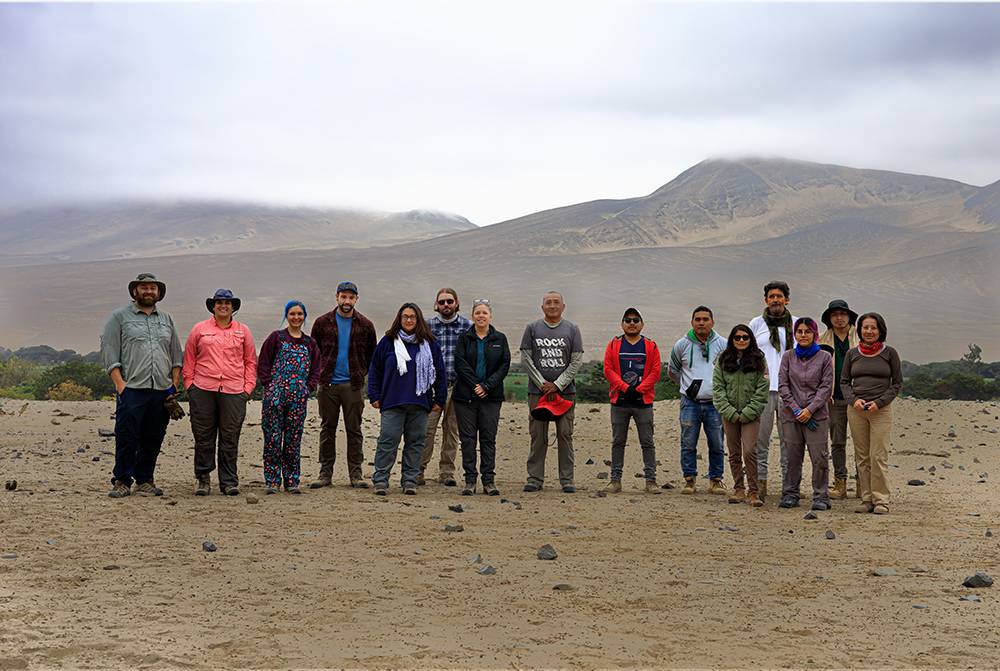
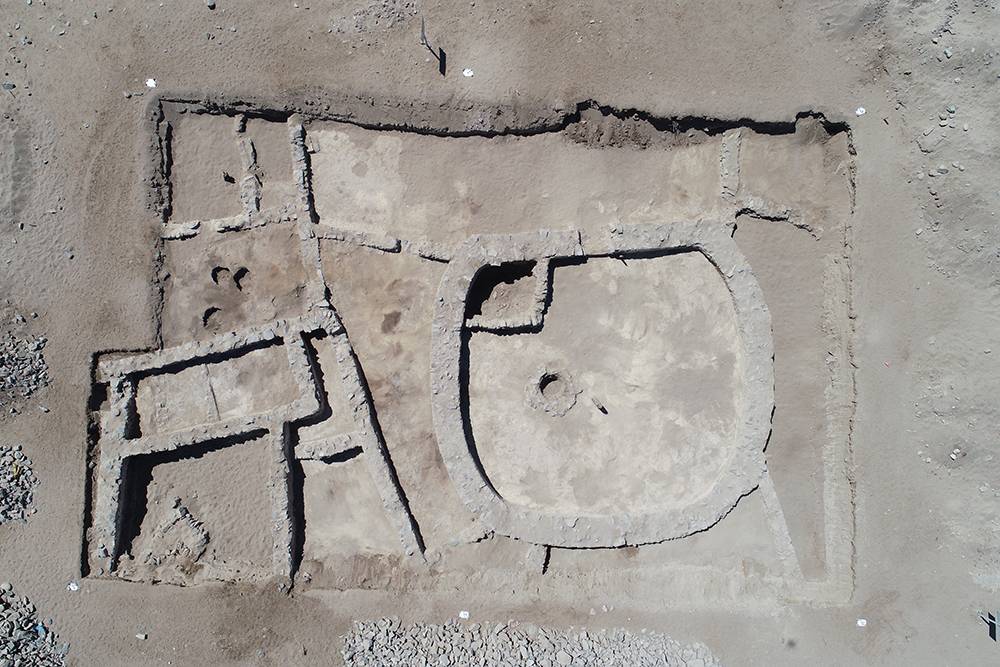
-
TAAS 2022
Texas Applied Anthropology Summit | 2022
Want to lean more about applied careers, sharpen your research skills, and network with other applied anthropologists? Join us for TAAS 2022 - an online event September 28 - October 1, 2022. The summit is open to all practicing anthropologists, faculty, and students interested in applied anthropology.
-
Graduate Student Open House
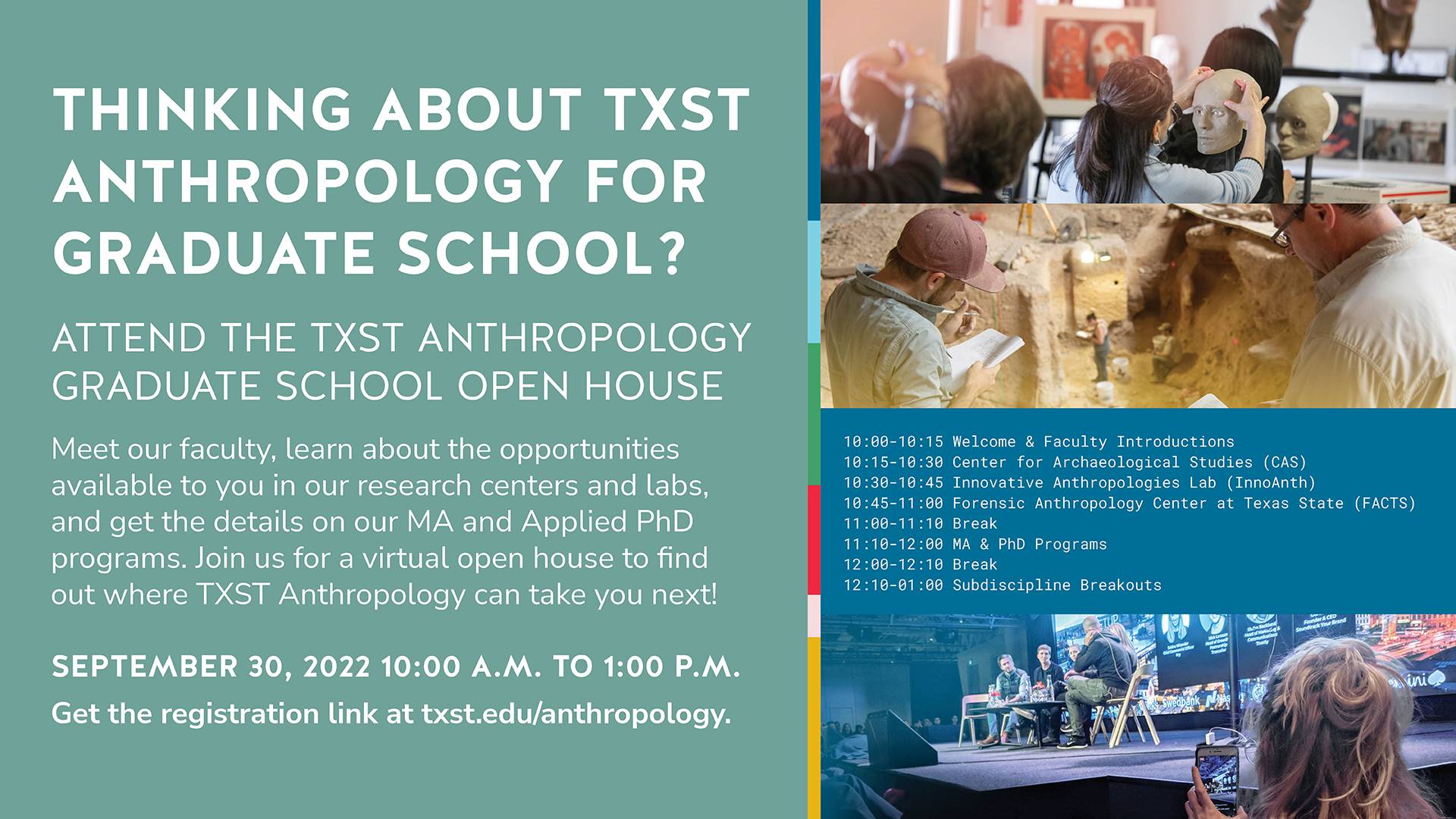 The Anthropology Department will host their annual Graduate Student Open House on Friday, September 30, 2022 from 10:00 am to 1:00 pm.
The Anthropology Department will host their annual Graduate Student Open House on Friday, September 30, 2022 from 10:00 am to 1:00 pm.Students interested in pursuing a Master's or Ph.D. at Texas State should attend to learn more about our graduate degree programs, course offerings, subdisciplines, academic Centers, and more.
Registration information and a schedule of events can be found on the Graduate Open House page.
-
Drs. Herrmann and Giordano (Geography) Awarded $1 Million in NSF Funding
Dr. Alberto Giordano (Department of Geography and Environmental Studies) and Dr. Nick Herrmann are co-leading a project entitled Migrant Mortality Mapping Portal Project (M3P2) that seeks to more accurately track migrate deaths along the border.
The three-year NSF project has two parts. First, the team will collect and organize big data on migrant deaths along the U.S.-Mexico border from various sources—from law enforcement reports to newspaper articles. Then, the team will develop a publicly accessible website where the data can be downloaded and explored with tools that the team will develop for exploring the data. Students will have opportunities to participate as research assistants in both areas. A post-doctoral researcher and doctoral and graduate research assistants will help the team with collecting and standardizing the data and designing and maintaining the database and tool.
You can read more about the project through the Texas State Newsroom.
-
-
Spring/Summer 2022 | News and Events
-
Texas Rock Art Speaks
Dr. Carolyn Boyd's recent identification of speech and breath in the rock art of the Lower Pecos is featured in the Digs & Discoveries section of Archaeology Magazine (July/August).
-
Congratulations to Professor Emily Bruson
Congratulations to Dr. Emily Brunson who be promoted to Full Professor September 1, 2022.
-
Research Conference Award Winners
Congratulations to the the winners of our Research Conference!
Ph.D.:
First place | Amy Reid
Second place | Eric Gauldin
Third Place | Rex LongMasters:
First Place | Tierney Proffit
Second Place | Druonna Collier
Third Place | Kayli LordUndergrad
First Place | Amanda Rodriguez
Second Place | Isabel Algoe
Third Place | Aubrey JacquesOlivia Green was also awarded a $25 prize.
-
Operation IDENTIFICATION on ABC Nightline
This 10-minute news story discusses the recovery of deceased migrants and the families who search for them. FACTS faculty, Drs. Spradley and Hamilton are featured with Applied Anthropology PhD students.
-
Dr. Reilly's Spiro Exhibit Wins Awards
Congratulations to Dr. Frank Reilly, whose recent Spiro Exhibit and publication, in collaboration with Dr. Eric Singleton of the National Cowboy Museum, won three combined awards.
The Spiro Publication won:
- The Oklahoma Book of the Year Award for Design/Illustration/Photography. This is presented by the Oklahoma Center for the Book, which is sponsored by the library of Congress.
- Mountain Plains Museum Association Book of the Year Award for Publication Design
The Spiro exhibition won:
- The Oklahoma Museum Association Outstanding Special Project Award.
-
Dr. Nicole Taylor's Research Featured in Discovery Magazine
Dr. Nicole Taylor's research on body image and social media is featured in a recent Discovery Magazine article, "How is Social Media Morphing our Self-Image?"
-
Doctoral Student Awarded P.E.O. Scholar Award
Congratulations to doctoral student Mariah Moe, co-advisors Drs. Tim Gocha and Kate Spradley, who has been awarded a P.E.O. Scholar Award. This $20,000 award recognizes and encourages scholarly excellence by women in doctoral programs. Mariah is one of 100 students selected from 775 applicants.
-
Dr. Jill Pruetz lectures on her research at the 5th Annual Women in Science Conference at Northeastern Illinois University
Dr. Jill Pruetz recently spoke on her research, entitled 'Studying Chimps at the Edge: Behavioral Ecology of our Closest Living Relatives at the Limits of their Range' at the 5th Annual Women in Science Conference at Northeastern Illinois University and sponsored in part by the Chicago Cancer Health Equity Collaborative. Dr. Pruetz was one of three biological anthropologists featured in the conference. A recording of her lecture can be found on YouTube.
-
FACTS faculty, staff, and students search for unidentified graves in Brownsville
Drs. Kate Spradley and Nicholas Herrmann along with PhD, MA, and undergraduate students conducted a geophysical survey of unmarked graves at Guillen Cemetery in Brownsville in preparation for exhumations next month. PhD candidate Mariah Moe also collected drone imagery for her dissertation. Mariah is working to develop a predictive model for identifying high probability areas for unmarked graves in cemeteries throughout South Texas.
The goal of the exhumations is to work towards positive identification and repatriation.
-
Sophia Mavroudas Receives Fullbright Award
Congratulations to doctoral student and FACTS coordinator, Sophia Mavroudas, Dr. Nick Herrmann advisor, who has received a Fullbright Award to Greece for 2022-2023. Sophia's project is titled “An Anthropological Approach to Identification in Medicolegal Contexts,” and her goal is to investigate increased migrant deaths across Europe and America. She will be working with two Greek forensic practitioners to research Greece’s migrant crises from the perspective of the Greek medicolegal system.
-
TXST Anthropology represented at the Society for Applied Anthropology Annual Meeting
 The Society for Applied Anthropology annual meeting was held in March, 2022 in Salt Lake City. Speakers included PhD students Eric Gauldin and Rex Long, MA students Kai Hart, Kayli Lord, Tierney Proffit and Emily Repasky, and faculty Emily Brunson, Nicole Taylor and Angela VandenBroek. #sfaa2022 #appliedanthropology
The Society for Applied Anthropology annual meeting was held in March, 2022 in Salt Lake City. Speakers included PhD students Eric Gauldin and Rex Long, MA students Kai Hart, Kayli Lord, Tierney Proffit and Emily Repasky, and faculty Emily Brunson, Nicole Taylor and Angela VandenBroek. #sfaa2022 #appliedanthropology -
Career Workshop in Anthropology
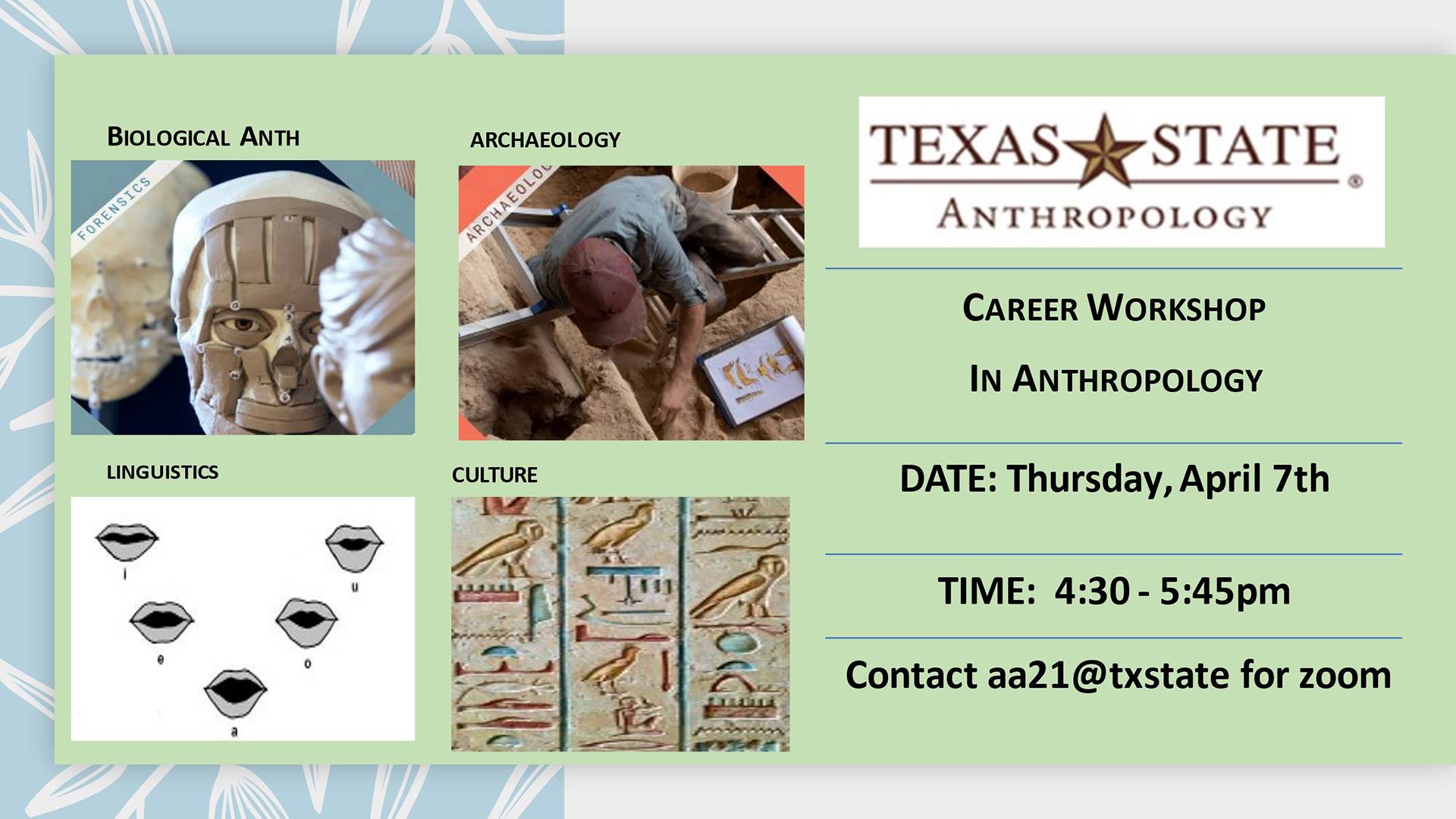 Date | Thursday, April 7, 2022
Date | Thursday, April 7, 2022
Time | 4:30 - 5:45 pm
Online via Zoom | Contact Dr. Augustine Agwuele for Zoom linkJoin the Department of Anthropology as we explore job prospects and career options in Archaeology, Biological Anthropology, Cultural Anthropology, and Linguistics with an Anthropology Degree.
Please contact Dr. Augustine Agwuele for any questions or to join the discussion.
-
Dr. Angela VandenBroek on Anthropology in Business Podcast with Matt Artz
In this episode of the Anthropology in Business podcast, Dr. Angela VandenBroek speaks with Matt Artz about her career as a business anthropologist. The conversation covers Angela’s journey from consulting and studying innovation, to teaching applied anthropology at Texas State University. Episode available on Spotify, Apple Podcasts, Stitcher or wherever you listen to podcasts.
-
Where archaeological science, art and indigenous knowledge intersect - The Hearthstone Project - is underway.
The Hearthstone Project is built on the results of the Alexandria Project and endorsed by the most prestigious national granting agencies in our field. This interdisciplinary and collaborative project with Texas State University is poised to reveal the mysteries of when and how the paintings were produced and what they were created to communicate. Dr. Phil Dering will be publishing a Hearthstone Project blog to keep you up-to-date with the project.
Check out the blog to follow along on our journey to unlock the many stories of the Lower Pecos Canyonlands of Southwest Texas.
-
Doctoral Student Receives Phi Kappa Phi Dissertation Fellowship
Congratulations to doctoral student Jennifer Barron, supervisor Dr. Michelle Hamilton, for receiving a Phi Kappa Phi Dissertation Fellowship. The award is to support students in the writing stage of the dissertation and is based on a student’s superior academic record and life/career ambitions.
-
Paleoethnobotany Workshop
Texas State University Anthropology students learned new skills in paleoethnobotany at Thursday and Friday's workshop at the new Archaeology Lab! Many thanks to our guest instructor Dr. Tim Riley (Utah State University-Eastern), the New Mexico Bureau of Land Management, FACTS, and Dr. Britt Bousman for their help and sponsorship!

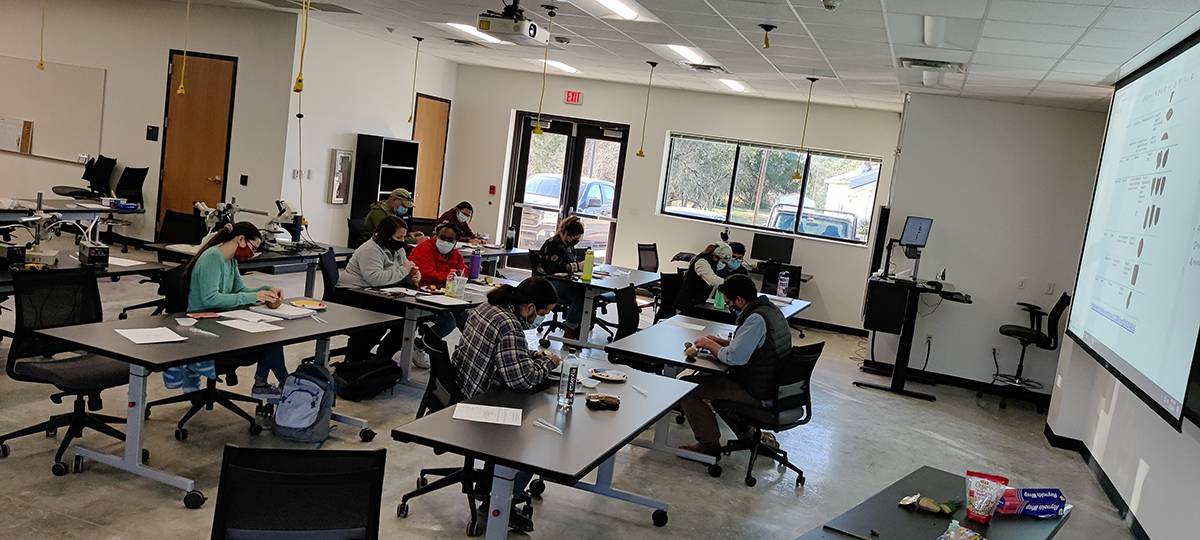
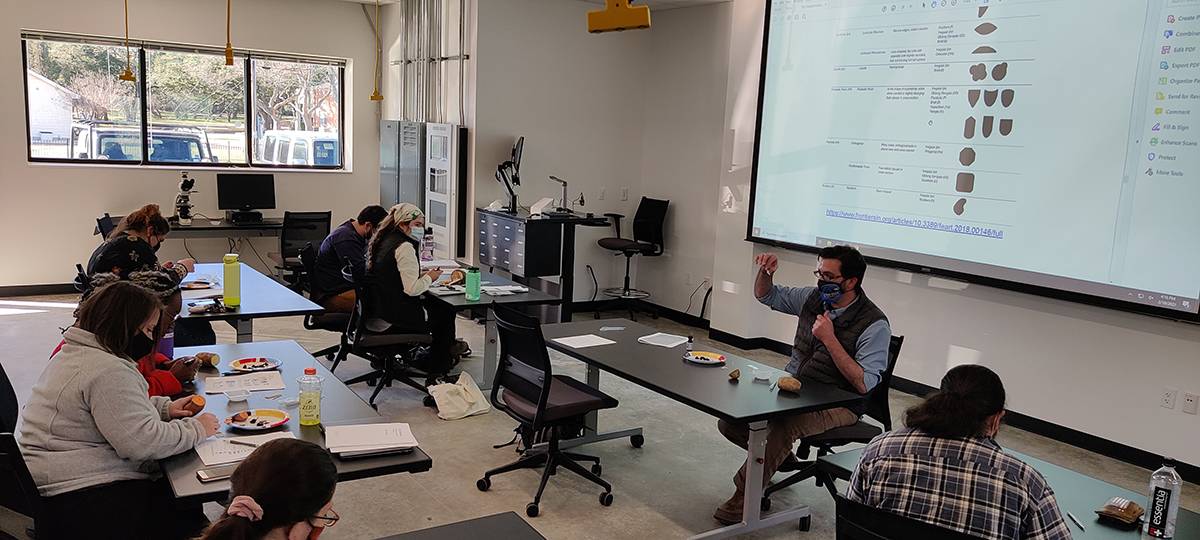

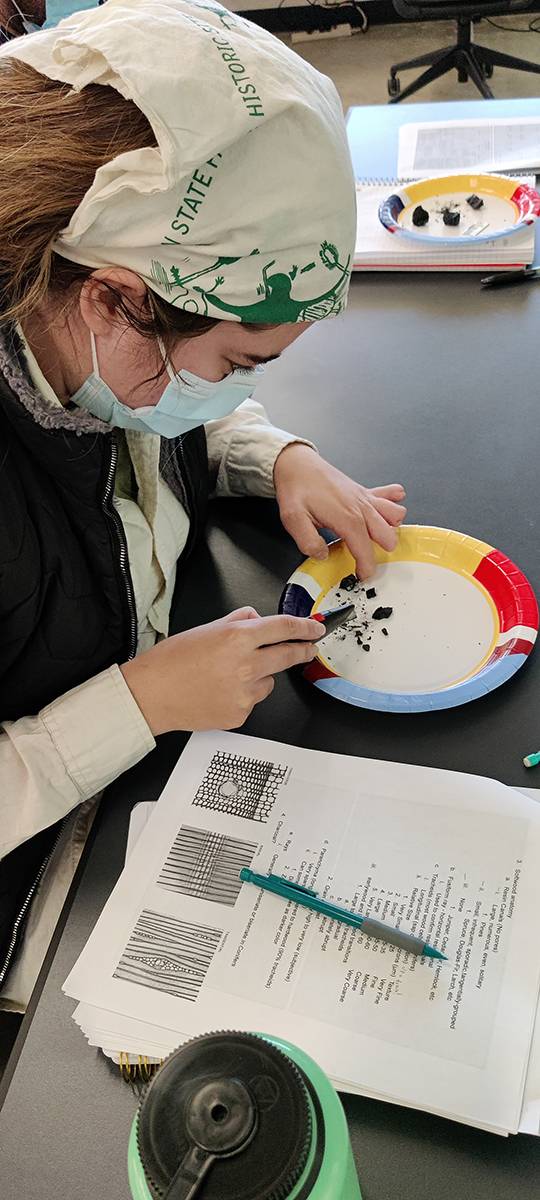
-
FACTS receives Community Partnership Award
Congratulations to FACTS for receiving a Community Partnership Award from the San Marcos Police Department for work that Danny Wescott, Sophia Mavroudas, JD Fancher and four students – Laney Feeser, Megan Veltri, Naomi Levin, and Hailey Collard-Stadler did on a forensics case. The team recovered skeletal remains and later identified the individual.

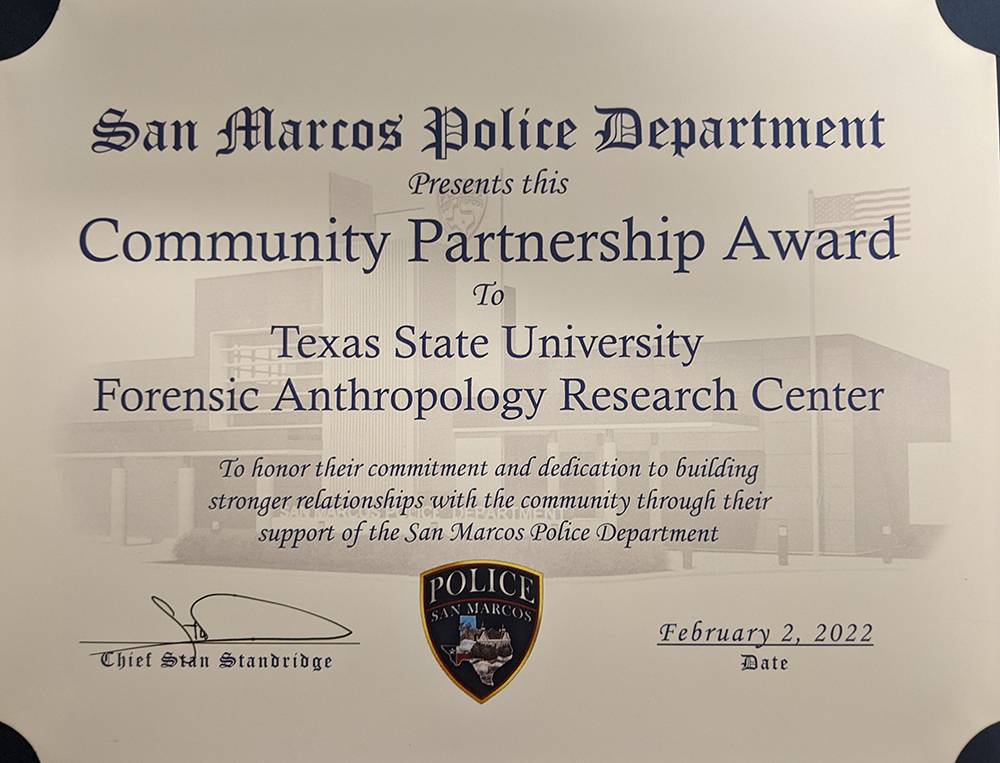
-
Dr. Nicole Taylor awarded NSF I-Corps Grant
Congratulations to Drs. NicoleTaylor (PI) and Jana Minifie (Co-PI, Dept. of Management) who were awarded a $50,000 NSF I-Corps Grant. Their team includes anthropology dept. alumnus Alejandro Allen, who is currently working toward an MSW in the School of Social Work. Together, they will assess the feasibility of a diagnostic tool, potentially a downloadable app, to promote mindfulness around phone use and mitigate the effects of "always on" technology culture in the US. As part of the I-Corps program, they will also participate in a series of training sessions to learn about developing a business canvas model through customer discovery research.
-
Dr. Nicole Taylor Co-authored New Book!
Congratulations to Dr. Taylor who recently co-authored a book (with Dr. Mimi Nichter) about youth and social media culture. A Filtered Life: Social Media on a College Campus (Routledge, December 2021).
-
Doctoral Students Interviewed by WLBT news in Mississippi
Doctoral students Petra Banks and Shelby Garza were both interviewed on the news in Mississippi about a recent FACTS workshop on identifying human versus non-human remains.
-
Congratulations to Steve, Amy, and others at CAS who helped to put together an exhibition of archaeological materials from Langtry, Texas
Congratulations to Dr. Steve Black, Amy Reid, and others at CAS who helped to put together an exhibition of archaeological materials from Langtry, Texas.
In 2017, Dr. Black and Amy Reid received funding from the Bank and Trust of Del Rio to prepare artifacts from the Skiles Collection for this Exhibit. CAS’s work included a collection evaluation, inventory, rehousing, and conservation. In 2019, CAS entered into a cooperative agreement with the Skiles Family and the Bank and Trust of Del Rio regarding the use, management and exhibition of the collection.
The collection came to CAS in 2016 as a loan from Mr. Jack Skiles, who was a long-time resident of Langtry, Texas, landowner and guardian of the Eagle Nest Canyon archaeological sites, author of Judge Roy Bean Country, keeper of the Skiles Collection (“Jack’s Museum"), and friend to generations of archaeologists and visitors. The Skiles Collection consists of Indigenous, Euro-American, and Asian cultural material. The Indigenous assemblage includes 1,685 artifacts collected from rockshelter sites within the Lower Pecos Archaeological region. Now, much of this material is on display in the Ancient Life In The Lower Pecos Canyonlands exhibit (see attached Reception Invite). In addition to the exhibit preparation, Amy assisted Dr. Black in the selection of artifacts for the exhibit and packaging for safe transport to Del Rio. Dr. Black developed all of the interpretive content for the Exhibit.
-
Dr. David Kilby Featured in Texas Montly
Congratulations to Dr. David Kilby whose archaeological research on Bonfire Shelter was recently featured in Texas Monthly.
-
